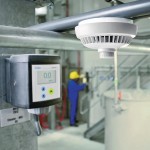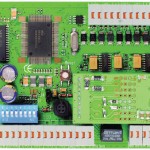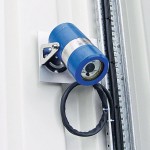When an accident occurs, toxic or explosive gases can quickly cause significant damage either by poisoning the air or by starting fires. To protect employees and plants, the ambient air must be continuously monitored and fire alarms integrated into the detection and warning technology. A warning system must identify the actual, current danger present at a glance, namely where gas has escaped and where a fire has started.
In recent years, both fire and gas detection technologies have become more intelligent. Today, gas detectors can identify hazardous gas particles in the ambient air quicker and more precisely. In addition to providing an on-site alarm and forwarding the warning signal to a control centre, these devices can directly intervene in operations to a certain degree, for example if an immediate shut-down of the plant is triggered. In fire detection technology, the spectrum of possibilities for fire detection has also expanded. Although this technology was long limited to smoke detection, multi-criteria sensors now simultaneously analyse the development of smoke, heat and CO concentration. In this way, fire can be identified in its beginning stages.
Classifying danger correctly
If an alarm is triggered in an industrial plant, it is often not possible to identify at a glance if just a fire has broken out or if gas has escaped as well. The reason for this problem is that in many plants, the instruments for identifying fire and those for detecting toxic or explosive gases are not networked. The alarm signals are not combined; instead, they appear in independent systems.
In practice, this means that when fire brigades arrive at the accident scene, only incomplete information regarding the local situation is available. The fire brigade display panel (FDP) depicts that an alarm has been triggered and shows the sensor that has triggered the alarm. The evaluation unit in the control centre must then be used to determine whether there has also been a gas leak. However, two separate overviews are often available there: the gas detection system and the fire detection system overview. In emergencies, valuable time can be lost waiting for the control centre to gain a transparent picture of the situation and for the rescue services to find out what danger they are going to face. To support those responsible and facilitate more efficient planning, the relevant data must be combined and processed in a clear and comprehensive manner.
Dräger has developed integrated fire detection technology and gas detection systems. The Dräger RFG 3000 interface component makes it possible to display information from fire alarm systems and gas detectors together. In this way, by taking a quick look at the FDP, the emergency team can see both the fire sources and the gas leaks. With their fire brigade route cards that display the positions of the fire alarm systems and gas detectors, they can localise all sources of danger precisely. At the same time, a screen in the control centre displays fire detection data and gas alarm messages together, so that the operation headquarters has quick access to an overview. In addition, all of the alarm data can be sent to a mobile pager system. This allows the security forces to monitor the plant around the clock and location-independently.
Data integration saves time
For this interface, Dräger combines its expertise in the two fields of gas and fire detection systems, offering comprehensive concepts for individually customised detection systems. This also includes combinations of several fire detection systems from different manufacturers, which can additionally be displayed on the control centre monitor. Currently, gas detectors that conform to Atex can be linked in this way with fire detection systems that are designed based on the requirements of the Association of Property Insurers (Verband der Sachversicherer/VdS).
Flame detection by video
The development of a fire cannot always be followed by observing smoke, heat or CO concentration. In some cases, the only way to detect a fire is by flame detection. Examples of this include fires in tank storage locations or engine test beds. Here, it is possible to use flame sensors, which are based on optical analysis, and reliably detect flames as they become apparent.
The Dräger Flame 5000 is based on video technology. It processes its own video signal via a signal algorithm. This algorithm interprets the movements and contours of flames – similarly to the human eye – thus detecting the typical characteristics of a fire.
This intelligent technology eliminates various commonly occurring interferences such as lightning, light reflections or thermal radiation, which can trigger false alarms when traditional sensors are used. The fire detection system receives the alarm signal from the Flame 5000. However, it also sends an image of the accident scene to the control centre monitor. In this way, users located outside the hazardous area likewise have a precise idea of the extent of the fire.
Moreover, with video technology it is also possible to protect the device itself from sources of danger: the detector can monitor the critical areas through an acrylic glass panel without being exposed to the extreme conditions. Thanks to its robust design, it is also approved for use in areas with explosion hazards. The detector records all algorithm sequences before and after each alarm. In this way, video recordings can be used after the fire to attempt to understand the cause of the accident.
The Flame 5000 meets the requirements of the EN 61508 standard, the international standard for the functional safety of safety-related electrical, electronic or program-mable electronic systems. In addition, the DIN EN 60204 standard, which includes specifications regarding the safety of machines and the machines‘ electrical equipment, requires that the probability of fail-ure for a safety function is designated in accordance with the so-called Safety Integrity Level (SIL) or Performance Level (PL). The Dräger Flame 5000 is certified in accordance with the requirements of SIL2. Moreover, the detector meets the requirements for Atex, IECEx, FM and CFM.
Online-Info www.cpp-net.com/2210443
Share:









